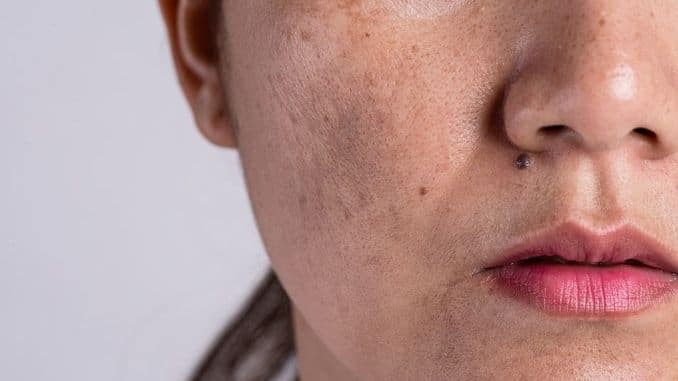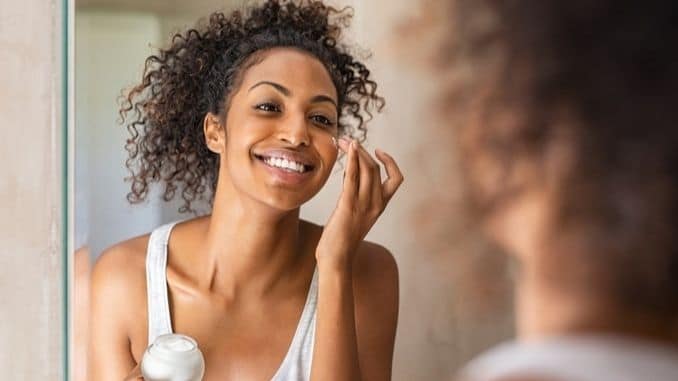
You look in the mirror and frown. You’ve been taking good care of your skin, but you still see dark spots, splotches, and patches that mark your appearance. This discoloration seems to stick with you no matter what you do, and you’re getting desperate.
Should you try one of those skin-bleaching creams?
Here’s why that might not be a good idea, and what you can do instead to fade dark areas and feel better about your complexion.
What Is Hyperpigmentation?
Hyperpigmentation is a common condition in which certain areas of the skin become darker than the surrounding skin. The darkening occurs when melanin, which is the pigment in skin that produces its color, becomes too concentrated in certain areas.
There are many different types of hyperpigmentation, including the following:
- Age spots: Also called liver spots or sun spots, these are small darkened patches that form on the face and sometimes also the hands and other areas of the body. These are caused by long-term exposure to the sun’s damaging ultraviolet (UV) rays, such as that which occurs after years of being outside. These may be brown or gray and are usually bigger than freckles.
- Freckles: These are small, concentrated spots that typically occur in clusters and vary in color from brown to tan to red. Those people with fair complexions are most likely to have them. The sun causes them, and they tend to run in families.
- Melasma: Yes, your revised sentence is already in active voice: “The sun causes them, and they tend to run in families.. Thyroid dysfunction can also be a factor. It creates a mask-like appearance ― also called “pregnancy mask” or “butterfly mask” ― with larger, splotchy dark areas on the cheeks, nose, forehead and sometimes the upper lip. The involvement of hormones makes treatment more difficult, as the condition affects the deeper layers of the skin. Sun exposure, stress and some medications can make the condition worse.
- Post-inflammatory hyperpigmentation (PIH): Traumas and injuries to the skin, such as acne, burns, friction or aggressive treatments, cause this type of hyperpigmentation. The skin responds to the injury by becoming inflamed and the dark area is left behind as it heals. These type of spots usually fade on their own with time.
All of these types of hyperpigmentation get worse with exposure to the sun. When UV rays reach the skin, they trigger the production of melanin, which is why you get a tan after sunbathing. In areas of hyperpigmentation where there is already too much melanin, sun exposure makes those areas darker and more pronounced.
Why Skin Bleaching Creams Aren’t the Safest Option
If you go out looking for a solution to your dark spots, you’re likely to come across several terms, including:
- Skin whitening
- Skin bleaching
- Skin lightening
- Skin brightening
In general, the first two are essentially the same and refer to a more drastic process of actually “whitening” the skin. In countries where whiter skin is prized, the pursuit of it is popular and typically involves aggressive ingredients and treatments meant to block the production of melanin. Resulting in the entire surface of the skin becoming lighter or several shades “whiter.
Skin lightening typically refers to a less aggressive but still serious approach to lightening dark areas of the skin while skin brightening is more about increasing glow and radiance. The safety of treatments for your skin depends on the ingredients used. Below are those that have been linked with dangerous side effects.
1. Hydroquinone
Safe Options for Skin Lightening: This is the most popular and safe option for skin lightening or whitening ingredient because it is effective. In the United States, it’s available up to a 2 percent concentration over-the-counter and at 4 percent or higher in prescription skin products.
When you apply hydroquinone to the skin, it blocks the action of an enzyme needed to make melanin. Over time, as there is less melanin for the skin to use, the dark areas fade. Results take time. Most users can tell the difference in about four weeks, but it can take up to 90 days.
Most people seem to tolerate hydroquinone well when used over a short period. The U.S. Food and Drug Administration (FDA) classifies it as safe at low concentrations. It can, however, cause side effects like irritation, dryness, itching, reddening, and allergic contact dermatitis. For this reason, it’s typically not recommended for dry or sensitive skin.
The problem is that it’s difficult not to use hydroquinone long-term. As long as you’re using it, you can keep the dark spots at bay. However, once you stop, the melanin resumes its production, and you can be back where you started.
There is also some concern that there could be a link between hydroquinone and cancer. Some animal studies have shown an association. But, so far, there are no human studies suggesting an increase in any types of cancer in those using the product. Animal studies showed that the ingredient, when ingested (not applied topically), could induce benign growths of tissue in the kidneys. Laboratory studies have also shown that hydroquinone can cause cancerous changes in cells, particularly bone marrow cells. This is when the cells were injected with the ingredient.
The International Agency for Research on Cancer (IARC) states that hydroquinone is not classifiable as to its carcinogenicity to humans because of a lack of evidence. We don’t know yet as we don’t have enough studies on the issue. That’s not exactly reassuring.
Finally, the ingredient can cause the formation of “halo spots” as it lightens the skin to which it is applied. You may find that your dark spots fade, but you develop lighter skin around those spots too.
Due to these and other issues, Europe has banned hydroquinone in over-the-counter formulations.
2. Mercury
Safe Options for Skin Lightening: In 2011, the Minnesota Department of Health warned state residents to stop using some types of skin-lightening products because they were found to contain dangerous levels of mercury.
The FDA also warned about the issue, alerting consumers to the fact that some s could contain mercury. State officials discovered numerous products with the ingredient. There were cases in which people exposed to those products developed mercury poisoning or elevated levels of mercury in their bodies.
Mercury is a powerful and effective whitening agent, but it’s also very dangerous. It can cause kidney and nerve damage, vision problems, muscle weakness and more, depending on the level of exposure and is particularly dangerous to children as it can harm developing brains.
To determine if your product contains mercury, look for ingredients like calomel, cinnabaris, hydrargyri oxydum rubrum, quicksilver, mercuric amidochloride, mercury oxide, mercurio or mercury salts. These ingredients are typically found in products that are manufactured abroad and sold illegally in the U.S. Often in shops catering to the Latino, Asian, African or Middle Eastern communities as well as online.
3. Steroids
In 2011, researchers reported that the media and online platforms extensively promote skin-lightening creams. They can contain potentially toxic ingredients like hydroquinone, mercury, and steroids. They tested 33 different brands and found corticosteroids above safe limits in many of them. Thirteen samples showed elevated levels of a steroid called cortisone, while three samples exhibited higher-than-safe limits of another steroid called dexamethasone.
Skincare formulas incorporate steroids to address specific skin conditions such as psoriasis, dermatitis, eczema, and rashes, primarily due to their inflammation-taming properties. However, extended use of steroids is not recommended, as it can lead to health problems.
In a 2014 study entitled “Misuse of topical corticosteroids: A clinical study of adverse effects,” researchers found that women were using the steroids to lighten skin color and treat melasma. Negative effects included acne and a condition called “telangiectasia,” which causes threadlike red lines or patterns on the skin.
Although short-term use of these ingredients isn’t likely to cause serious issues, long-term use can result in “skin atrophy.” This causes thinner, more fragile skin, tenderness, increased photoaging and more visible blood vessels. Steroids can also increase the risk of acne, rosacea, perioral dermatitis (facial rash around the mouth), delayed wound healing and other issues.
Whitening or lightening creams with steroids in them typically claim to give “faster and better results,” and are typically imported from other countries and found in ethnic shops. In the U.S., only very low-potency topical steroids are available over the counter. Typically found in anti-itch and anti-inflammatory creams like Cortizone 10, not in lightening creams.
For Skin Lightening, Choose Safer Options
Safe Options for Skin Lightening: Fortunately, you can still help fade those dark spots by using safer ingredients from reputable brands. Some of the best lightening ingredients include:
- Arbutin: A natural derivative of hydroquinone found in plants like bearberry and blueberry, this ingredient can significantly lighten the skin without the dangers of hydroquinone.
- Ellagic acid: This natural substance comes from fruits like berries and pomegranates and helps inhibit the enzyme used for melanin production.
- Kojic acid: An antioxidant that comes from a fungus, it breaks down melanin in the skin and also prevents its production in the future.
- Licorice: These are derived from the licorice root and may help lighten skin. It also helps to inhibit the enzyme needed to produce melanin.
- Lignin peroxidase: It comes from a fungus found in wood pulp and helps break down melanin in the skin.
- Niacinamide: This is a form of vitamin B that inhibits the transfer of melanin cells into the skin’s upper layer. It helps to prevent additional pigment from coming to the surface of the skin.
- Vitamin C: This vitamin, when applied topically, increases cell turnover in the skin, getting rid of surface cells and allowing younger cells to rise to the top more quickly, which can help lighten darker areas as new skin comes into place.
- Retinol: A form of vitamin A, it helps to treat skin aging by stimulating the production of new cells, and it can also help to fade dark spots.
For your guide to the best foods to heal your body, make sure to check out The Best Foods that Rapidly Slim & Heal in 7 Days, here!
.



